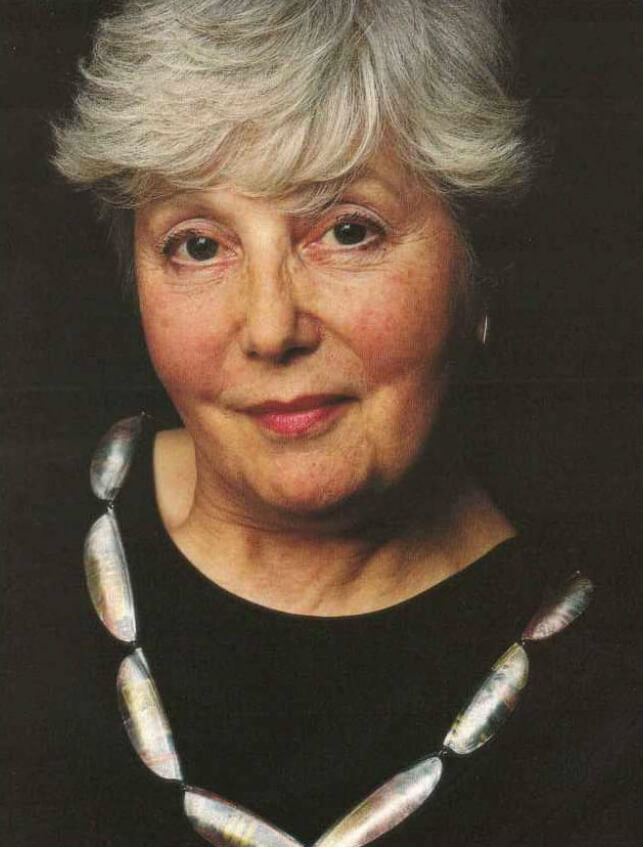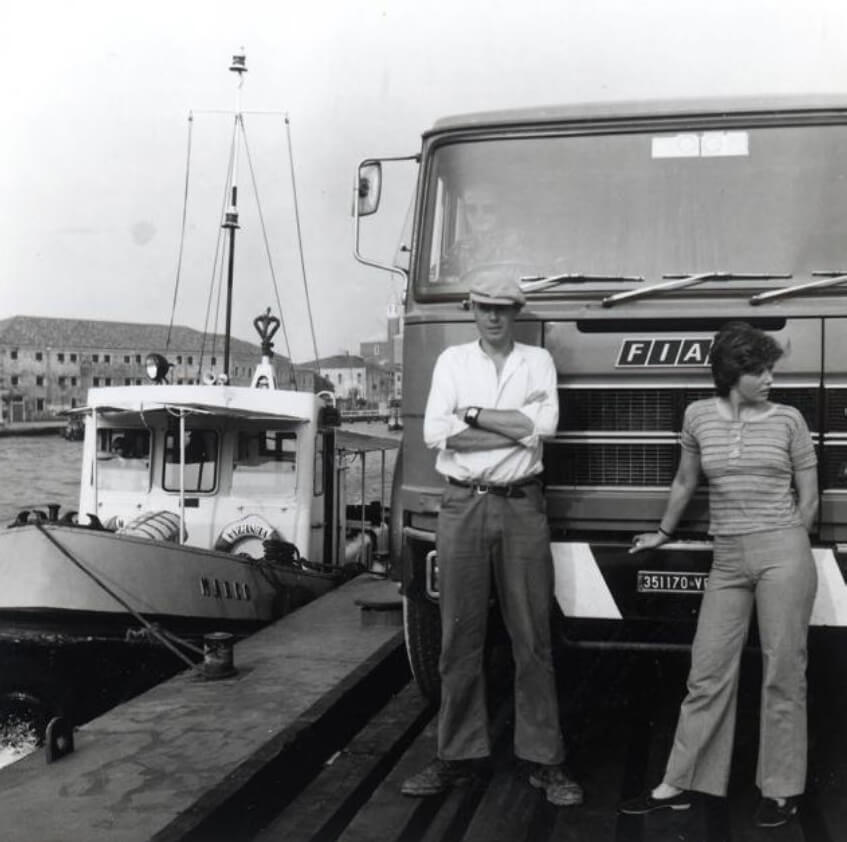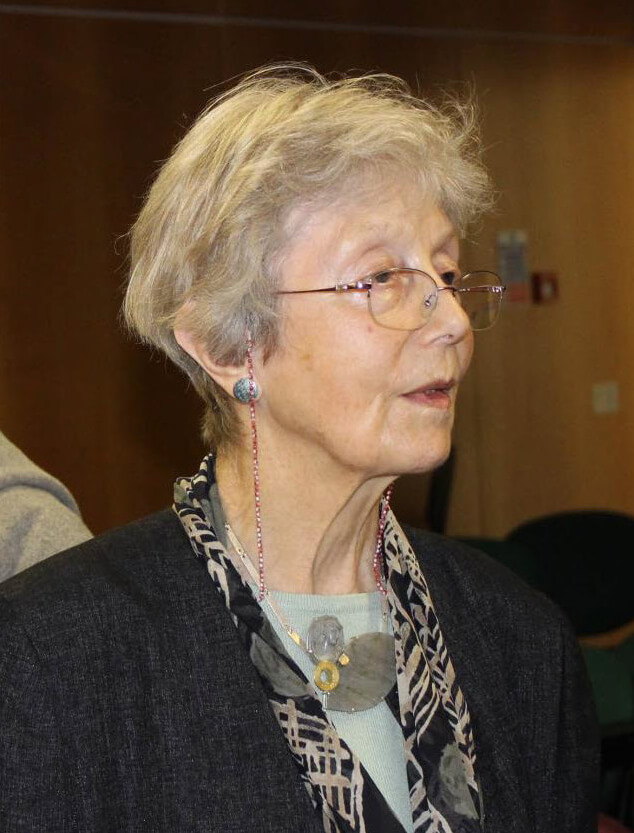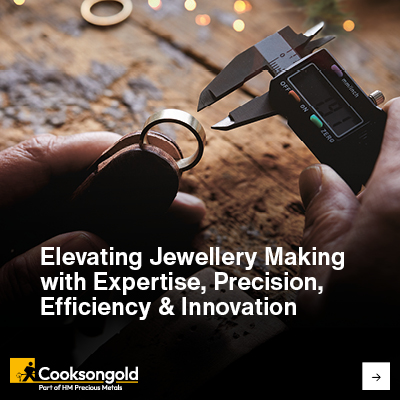Muriel Wilson 1933 – 2018
Reading Time:
1 min {{readingTime}} mins
Muriel was a Founding Member of ACJ, and was for seven years our Honorary Secretary. She initiated our print magazine Findings and served as its Editor for 15 years, from 1998 to 2013. She was a keystone member of ACJ and keeper of its history. She retired from the Board meetings in 2014 (always identified as attending ex officio Editor of Findings) and thereafter served on our Panel of Advisors wirites Tamizan Savill from the Association for Contemporary Jewellery in Muriel Wilson's obituary.
Jane Adam wrote “Muriel proved herself to be pivotal to the formation of ACJ, giving us a good grounding and structure, one from which it has been able to grow and flourish.”

Muriel was born in South Wales in 1933, to artist Alfred J Lavender and Ida Winter, both from Gateshead, Northumberland. She studied for a BA at the Courtauld Institute of Art 1951-4, and was involved with the Independent Group at the ICA and their seminal 1956 exhibition This is Tomorrow at the Whitechapel Art Gallery, before beginning her career in the Museum Service in Birmingham. She took up fencing as a sport and was a keen member of the London Thames Fencing Club for many years.
At the Courtauld, she met tutor and architectural critic Reyner Banham; he and his wife Mary became
lifelong friends, and introduced her to her husband, the architect Colin St. John Wilson. After marrying, they lived next to the Banhams in Primrose Hill, until moving to Cambridge. Muriel worked for the Arts Council in a Cambridge gallery, and Sandy was appointed a professorship at the Cambridge School of Architecture; Muriel was like a University Aunt to some devoted and subsequently famous students there.
Muriel’s younger sister Gillian Meller and her nieces Claire and Tracy Meller are also architects, and architecture was an abiding area of passionate interest for her.
After her divorce in 1971, Muriel moved to London and joined the British Council, working her way to becoming Curator of the British Council Collection, and eventually Director of Visual Arts. She was instrumental in introducing many important overseas artists to UK audiences and UK artists to the world; she brought Anish Kapoor to the UK for the first time, and took Richard Long to the Venice Biennale in 1976 (helping to shift his large pile of stones from a barge!).

1976: Artist Richard Long and Muriel Wilson from the British Council transport the stones for his exhibition on a barge across Venice. Photo: Julian Andrews © British Council
She also curated Urban Images, an exhibition of prints.
She made friends with many artists, including Peter Blake, and collected a large number of original works, prints and etchings, which decorated her small apartment in Saint John’s Wood with an eclectic and exciting display.
In 1991 the British Council acquired jewellery for its Craft Collection to form the circulating exhibition ‘All that glisters’…New Jewellery in Britain; mainly work in non-precious materials by leading UK makers, including Jane Adam & Clara Vichi. This exhibition was curated by Muriel and toured from 1992 for several years to Bahrain, India, Malaysia, Thailand and other countries. The British Council later donated the collection to the Crafts Study Centre, UCA Farnham. Muriel was particularly pleased with the showcases cum crates she designed: the jewellery was sewn to the backing of sturdy showcases which were transported intact to each venue; these prevented damage, poor display and the possibility of theft, and eased transport.
On retirement she was awarded an OBE, which she declined to accept because it “came with the job” rather than through personal merit. She now had time to indulge her passion for the decorative arts, and in particular, contemporary jewellery, and seemed to have boundless energy in these pursuits. She joined various societies, and was extremely generous with her time, serving on several committees and councils; contributions were always apposite and useful. As well as editing Findings, Muriel was Managing Editor of Jewellery History Today for the Society of Jewellery Historians.
She led numerous group visits to places of interest around Europe for the Victorian Society, the Decorative Arts Society, the 20th Century Society and others; for these she’d go for a thorough recce and research visit before the group tours. Fiercely independent, very knowledgeable and eternally curious, Muriel was a mine of information on an extremely wide field of subjects.
The Arts and Crafts movement was a major interest; she spent many hours researching in the library at Goldsmiths’ Hall, and was a volunteer archivist alongside Dr Ann Shannon. Muriel wrote a paper on the work of Omar Ramsden, published in the Oxford Dictionary of Biography. She was also interested in the Artificers’ Guild, and in particular in the work of John Bonner. After finding that the Museum of Cardiff had a collection of Bonner’s drawings and some pieces of his work, she spent hours on many visits researching these, and was able to increase the Museum’s collection, through contacts with dealers and with the Bonner family. She discovered the existence of much of his work around Britain, not only in jewellery but also in stained glass. She wrote an article about him for Jewellery History Today and also wrote a history of a fine Bonner pendant which she found and persuaded the Cardiff Museum to acquire: In Homage to St Winefride, Arts and Crafts Necklace. Her ambition was to curate a small exhibition of his work using their collection and loans contributed by his family, and she was pursuing this up to her demise, having almost completed the catalogue.
Contemporary jewellery and its makers were Muriel’s major passion, though; her small, elegant figure, suitably adorned with interesting rings, brooches and small earrings, could be seen at every Goldsmiths’ Fair, New Designers, Cockpit Arts Open Studios, PVs of interesting jewellery exhibitions and practically all ACJ events, and her “roving reporter” pieces for ACJ were extremely well written. A staunch supporter of the artists she admired, including new graduates, she could tell you about the maker of each piece she wore & how it was made. Muriel had a dry (and sometimes wickedly scathing) sense of humour and a comprehensive knowledge of makers and their doings.
In an article for the 20th Century Society in 2013, Muriel wrote about her large bracelet, made by Maria Hanson:
“This is emphatically not an everyday piece; its 20cm span means that wearing it at a crowded party confers heavy responsibility to avoid puncturing other guests, but I discovered that its effect is most impressive when the wearer’s arm is gracefully raised to wave nonchalantly at a friend across the room.”

For Muriel’s 80th birthday in 2013, we organised a tea party at Goldsmiths’ Hall, attended by a host of very well-known jewellers; most were her personal friends.
To mark this special birthday and her retirement as Editor of Findings, ACJ members and friends together donated a thousand pounds for Muriel to commission and special piece.
She chose Zoe Arnold, who made her a brooch which can be converted into a necklace, incorporating very personal connections & inspirations.
Muriel wrote: “The long gestation of the brooch increased the exciting prospect of acquiring something so intimately personal and so beautiful. The novelty of the process of commissioning something so important, which the generosity of so many friends had made possible, will stand as a landmark for me as an aspiring collector of contemporary jewellery and passionate devotee of beautiful things in all media.”
The article on this commission is here.
Personally I found Muriel inspiring, funny and fascinating, and I will miss my friend’s company, wit and conversation.
Written by Tamizan Savill, Development Manager, Association for Contemporary Jewellery.
References
http://visualarts.britishcouncil.org/exhibitions/exhibition/urban-images-1983
https://acj.org.uk/index.php/archive/jewellery-articles/280-muriel-wilson-jewellery-commission
Image Credits:
Muriel wearing a Jane Adam necklace, circa 1998
1976: Artist Richard Long and Muriel Wilson from the British Council transport the stones for his exhibition on a barge across Venice. Photo: Julian Andrews © British Council
Author:
Published:








